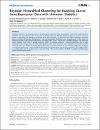Training Radial Basis Function Neural Networks for Classification via Class-Specific Clustering
| Author | Raitoharju, Jenni |
| Author | Kiranyaz, Serkan |
| Author | Gabbouj, Moncef |
| Available date | 2021-03-25T11:33:36Z |
| Publication Date | 2016 |
| Publication Name | IEEE Transactions on Neural Networks and Learning Systems |
| Resource | Scopus |
| Abstract | In training radial basis function neural networks (RBFNNs), the locations of Gaussian neurons are commonly determined by clustering. Training inputs can be clustered on a fully unsupervised manner (input clustering), or some supervision can be introduced, for example, by concatenating the input vectors with weighted output vectors (input-output clustering). In this paper, we propose to apply clustering separately for each class (class-specific clustering). The idea has been used in some previous works, but without evaluating the benefits of the approach. We compare the class-specific, input, and input-output clustering approaches in terms of classification performance and computational efficiency when training RBFNNs. To accomplish this objective, we apply three different clustering algorithms and conduct experiments on 25 benchmark data sets. We show that the class-specific approach significantly reduces the overall complexity of the clustering, and our experimental results demonstrate that it can also lead to a significant gain in the classification performance, especially for the networks with a relatively few Gaussian neurons. Among other applied clustering algorithms, we combine, for the first time, a dynamic evolutionary optimization method, multidimensional particle swarm optimization, and the class-specific clustering to optimize the number of cluster centroids and their locations. |
| Language | en |
| Publisher | Institute of Electrical and Electronics Engineers Inc. |
| Subject | Computational efficiency Functions Neural networks Optimization Particle swarm optimization (PSO) Radial basis function networks Supervised learning Benchmark data Classification performance Clustering methods Evolutionary optimization method Input-output clustering Multi-dimensional particle swarm optimizations Number of clusters Radial basis function neural networks Clustering algorithms |
| Type | Article |
| Pagination | 2458-2471 |
| Issue Number | 12 |
| Volume Number | 27 |
Files in this item
| Files | Size | Format | View |
|---|---|---|---|
|
There are no files associated with this item. |
|||
This item appears in the following Collection(s)
-
Electrical Engineering [2811 items ]


